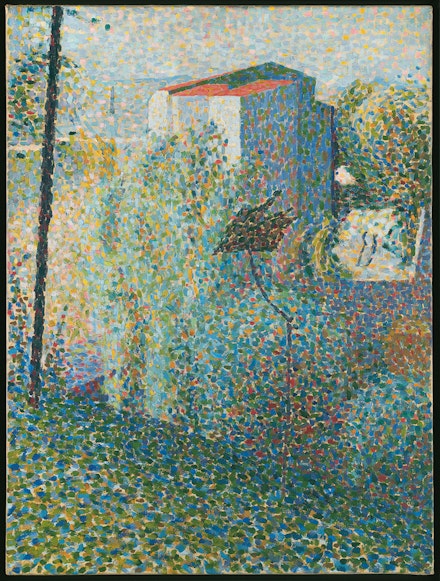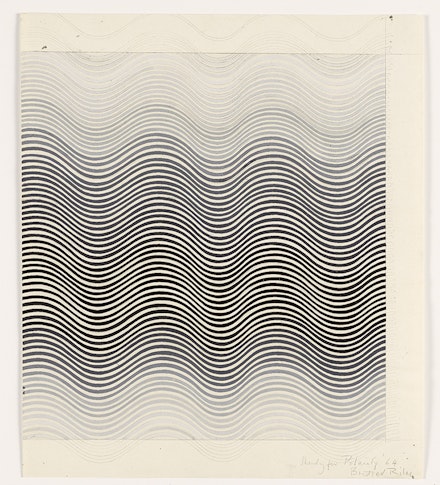ArtSeen
Bridget Riley Drawings: From the Artist’s Studio
![Bridget Riley, <em>Final Study for “Halcyon”</em> <em>[Repaint]</em>, 1971. Pencil and gouache on paper, 37 3/8 × 36 inches. Collection of the artist. © Bridget Riley 2023. All rights reserved.](https://brooklynrail.imgix.net/content/article_image/image/37557/ostrow-riley-1.jpg?w=440&q=80&fit=max)
On View
The Morgan Library & MuseumBridget Riley Drawings: From the Artist’s Studio
June 23–October 8, 2023
New York
Until seeing Bridget Riley’s exhibition Bridget Riley Drawings: From the Artist’s Studio, at the Morgan Library, I hadn’t given her work much thought. She tended to be one of those shadowy memes that stalk the margins of late-modernist abstract painting’s history. When I do think of her work, it is in the context of Ross Bleckner, Philip Taaffe, and Steve DiBenedetto’s 1980–90s appropriations of Op art tropes. So, when viewing this exhibit of approximately seventy-five works on paper, I found the working drawings, in which she develops the effects and designs to be used by her studio assistants in executing her paintings, of particular interest. Among these there are patterns and imagery that I was unfamiliar with, such as Study for “Hidden Squares” (1961), consisting of a black-on-white pattern of dots and squares, and, in the exhibition’s accompanying catalogue, Study for Stage Sixty Symbol (1961–65), which is reminiscent of Marcel Duchamp’s Rotary Demisphere (Precision Optics) (1925). These works’ pictorial strategies, and others from the 1970s on, though their initial effects are still op, align them with many of the now marginalized practices of post-fifties hardedge and geometric abstract art. With this insight, I realized Riley’s practice extends beyond her association with Op art and that her work can be contextualized within the broader aesthetic discourses of early and late modernism.
Op art, short for Optical art, emerged in the 1960s as a distinct practice, which focused on creating optical sensations of movement, depth, and visual ambiguity. Lawrence Alloway, the British art critic and curator, recognized the influence on Op art’s development of scientific discoveries particularly in the fields of psychology and optics, as well as advancements in technology. By emphasizing the active role of the viewers’ perception, Op art departed from the traditional notions of painting as a static and passive art. In Riley’s works, lines seem to dance, patterns appear to vibrate, and colors pulsate with energy; the viewer is drawn into a world of visual instability where perception is manipulated, and reality becomes a subjective experience. Because Op art sought to engage the viewer in such an immersive visual experience, Alloway viewed it as a response to the changing social conditions shaped by technological advancement and popular culture.
Riley’s identification with Op art was initiated by her participation in the influential exhibition The Responsive Eye, held at the Museum of Modern Art in New York in 1965. This exhibition brought together an international array of artists using abstract art to explore optical effects and illusions. These artists working out of differing traditions were stylistically diverse. So, where Riley’s works emphasize the allusion to movement through organic patterns and vibrant colors, others such as Richard Anuszkiewicz focused on the exploration of color. Still others explored the impact of specific forms, arrangements, and colors on the viewer’s visual experience, employing strict rules and using mathematical systems or algorithms to guide the creation of their artworks.

Riley’s association with Op has had both positive and negative consequences on her career. Critics have praised her for her ongoing innovative exploration of visual phenomena, while others perceive Op as purely gimmicky and overly accessible—in other words, middle-brow. A more generous view of Op is that it is one of the four distinct movements of late-twentieth-century modernism, the others being Pop art, Minimalism, and Color Field. The aesthetic qualities and commitment to literalness that define these movements are like threads weaving through the fabric of late modernism. By prioritizing differing aspects of painting’s inherent qualities, these practices were shaped by and gave shape to formalism’s discourse. Even Pop art, which incorporates popular culture imagery and tends to be mimetic rather than abstract, is built on this formalist foundation. Such a heterogeneous account of late-modernist painting offers a critical lens through which Riley’s work can be discussed and situated.
Viewing the range of motifs and strategies Riley has employed over the last seventy years, I realize that, though Op art continues to be significant to Riley’s reputation and market, it has also inhibited recognition of the fact that her endeavors transcend that categorization. Drawn to exploring the internal world of perception and subjective experience, Riley challenges her audience’s cognition of the external world. From this perspective, her focus on the phenomenological can be understood as a response to a world in which experiences were being increasingly fabricated and mediated. By the late 1970s, the notion of a painting as an event would wane as formalism reified into a formula rather than a means to explore painting’s identity.
So, once I stopped looking at her work as Op, it became apparent to me that Riley’s intricate geometric patterns and meticulous execution share similarities with the proto-minimalist tendencies of the 1960s and 1970s. Riley’s exploration of color, optical space, and precision aligns with that of the hard-edge abstract paintings of artists such as Edwin Ruda and Dean Fleming, who were associated with the Park Place Gallery and whose general aesthetic was reductivist. These artists, like Riley, prioritized the clarity of structure, the visual interplay of shapes and lines, with the exploration of color-form relationships. Likewise, though stylistically different, the composition of works such as Scale Study, Open Disks, Olive, Turquoise, Cerise (1970), with its pattern of dots made up of concentric rings of color, and Final Study for “Halcyon” (1971), with its pattern of tapering stripes, also have an affinity with some of the Washington Color School painters such as Thomas Downing, Gene Davis, and Kenneth Noland, among others, who also employed vibrant colors and simple geometric forms such as stripes and circles and patterns.

The bridge between all these differing trends at the time was systemic art, a practice that emerged in the 1960s and focused on non-intuitive approaches to composition. Though stylistically varied, these artists made serial paintings based on repetition and variation, amongst them were Frank Stella, Ellsworth Kelly, Robert Mangold, Agnes Martin, Kenneth Noland, and Robert Ryman, who, similar to Riley, employed rules dictated by logic and formal concerns. In summing up this trend, Alloway again played a significant role in its definition and promotion: in 1966 he curated the exhibition Systemic Painting at the Guggenheim Museum. Though no longer referenced because it has become a norm, this practice at the time played an important role in the formulation of Minimalism and Conceptual art.
Another context for Riley’s interest in optical effects and visual perception is the historical one of artists such as Giacomo Balla, Stanton MacDonald-Wright, and Robert and Sonia Delaunay, and such movements as Futurism, Synchronism, Vorticism, and Orphism, whose experiments with color and dynamic compositions advanced abstract painting. Futurism and Vorticism are of particular importance because fifty years later Riley would also employ fragmented forms, intersecting lines, and vibrantly colored patterns to convey a sense of motion and energy. By placing Riley’s work within these diverse contexts, the exhibition extends beyond its association with Op art and invites us to critically appreciate the interconnectedness of the evolution of artistic practices, which forms a continuum across different periods.

